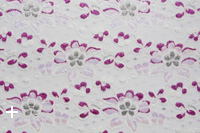
New bra concept for Jacquardtronic Lace
The women of Southeast Asia are delicate and beautiful, and they know just how to make the most of their features by wearing the right sort of clothing. Women have worn the kebaya here for centuries to assist them in the delicate art of seduction. This close-fitting blouse-dress found its way into Indonesian women’s dress in the 15th century, and has now become part of the national dress in this island state as well as in Malaysia and Singapore. The design of

14th October 2010
Knitting Industry
|
Obertshausen
 The women of Southeast Asia are delicate and beautiful, and they know just how to make the most of their features by wearing the right sort of clothing. Women have worn the kebaya here for centuries to assist them in the delicate art of seduction. This close-fitting blouse-dress found its way into Indonesian women’s dress in the 15th century, and has now become part of the national dress in this island state as well as in Malaysia and Singapore.
The women of Southeast Asia are delicate and beautiful, and they know just how to make the most of their features by wearing the right sort of clothing. Women have worn the kebaya here for centuries to assist them in the delicate art of seduction. This close-fitting blouse-dress found its way into Indonesian women’s dress in the 15th century, and has now become part of the national dress in this island state as well as in Malaysia and Singapore.
The design of this feminine garment is based on traditional roots, but is constantly reinventing and updating itself with each passing era. In short, it is a classic garment which women still love to wear today.
The modern kebaya still owes much to its roots and features sleeves, a collarless neckline and fasteners down the front. The material used to produce it is usually semi-transparent and the feminine decorative effects on the outside are worked to give it a modern twist. Sophisticated patterns, bright colours and modern materials bring lifestyle chic into a woman’s wardrobe and a touch of ‘vava voom’ to tradition.
One example of this is the warp-knitted fabric shown on the right. This delicate fabric was produced on a Karl Mayer JL 42/1B and its silvery, shimmering mother-of-pearl look creates exquisite effects. The Jacquardtronic Lace machine worked Lurex yarns over the surface to coordinate the floral motifs with the overall shiny, shimmering look. The metallic yarns were delivered from pattern beams, each equipped with a pattern beam drive.
This enables the Lurex yarns to be fed to the machine even at high production speeds without any problems. By using Karl Mayer’s pattern beam drives, high-quality kebaya fabric can be produced successfully for the first time at a speed of 700 rpm from tension-sensitive Lurex yams, a spectacular level of performance, especially in view of the marked tendency of the inelastic yarns to become twisted.
To produce this fabric, the Lurex yarns are processed with textured PES yarns, which are fed from a creel.
Article reproduced with the kind permission of Karl Mayer

Business intelligence for the fibre, textiles and apparel industries: technologies, innovations, markets, investments, trade policy, sourcing, strategy...
Find out more